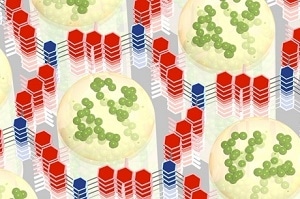Sep 2 2016
 A conductive polymer (green) formed inside the small pores of a covalent organic framework (red and blue) works with the framework to store energy rapidly and efficiently. (Credit: Cornell University)
A conductive polymer (green) formed inside the small pores of a covalent organic framework (red and blue) works with the framework to store energy rapidly and efficiently. (Credit: Cornell University)
A team of researchers from Cornell University have invented a technique to merge the large energy-storage capacity of batteries with the higher charge-discharge rate of supercapacitors in order to develop a strong electrical energy storage (EES) device.
This new technology is based on a covalent organic framework (COF) charged with an electronically conducting polymer thin film. It is considered to be beneficial for several technologies including automotive, as it could increase the speed of the charging process, expand the single-charge range, and also be integrated into the car’s body.
Because it is the film that is really providing the charge capacity, it has an infinite form factor. Any conducting surface can serve as a current collector.
Hector Abruña, Emile M. Chamot Professor of Chemistry, Cornell University
This research was recently published in the American Chemical Society journal Central Science, and is the latest installment of an ongoing partnership between Abruña and Will Dichtel, former Cornell assistant professor of chemistry and chemical biology, who is now at Northwestern University.
The team’s paper is titled “Superior Charge Storage and Power Density of a Conducting Polymer-Modified Covalent Organic Framework.” Catherine DeBlase Mulzer, Ph.D. ’16, a senior chemist at Dow Chemical, was first author. Other contributors were postdoctoral research fellow James R. McKone and graduate students Luxi Shen and Na Zhang.
The research focuses on COFs - porous crystalline structures that are capable of being fashioned into lightweight building blocks with a wide range of applications. Standard COFs were observed as comprising limited potential for electrical energy storage, mostly due to their poor conductivity.
A technique to overcome this limitation was developed by the researchers: electropolymerizing a thin film of poly (3,4-ethylenedioxythiophene), referred to as PEDOT (an electronically conducting polymer) - with the COF pores that are grown on a base layer, or a conducting substrate.
The improved COF film displayed a 10-fold higher current response in contrast to COF films that are unmodified. The film also exhibited steady charge-discharge for almost 10,000 cycles.
“The concept is very simple, and the execution was such that it worked,” said Abruña, who in July was awarded the Electrochimica Acta Gold Medal in recognition of his sustained excellence in multidisciplinary studies of electrochemical phenomena. Electrochimica Acta is the official publication of the International Society of Electrochemistry.
The researchers proved their theory by placing their improved 1-micrometer-thick COF into a coin cell battery prototype and then powering a light-emitting diode for 30 seconds.
“It’s one of those rare occasions when you say, ‘Wow, it really worked as designed,’” he said.
Abruña stated that he has been in touch with car manufacturers with regards to the possibilities this thin-film EES technology.
My standard line is, ‘Don’t call it a door – call it a high energy-density module, because you can coat the inside [of the car door] with this directly on the metal before you paint it, now you have a door that also stores electricity. Yes, this is down the line, but it has a lot of potential.
Hector Abruña, Emile M. Chamot Professor of Chemistry, Cornell University
Moving forward, the researchers will be focusing on extremely thicker COF films than the 1-micrometer [1,000-nanometer] films used in this work. Earlier work with EES devices using two-dimensional COFs exhibited their extremely thin (50-nanometer) films or multilayer sheets.
This work received a grant from the National Science Foundation, as well as a Department of Energy grant to the Energy Materials Center at Cornell, which Abruña directs. The research took place at the Cornell Center for Materials Research and the Nanobiotechnology Center shared facilities.